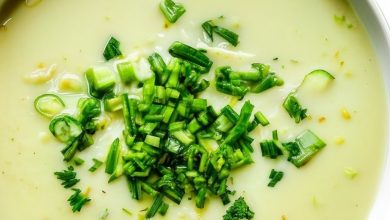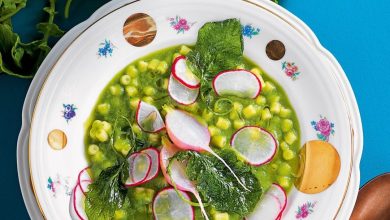Scandinavian Prune and Apple Stuffed Pork Tenderloin
Introduction
Embark on a culinary journey to Scandinavia with this exquisite recipe that combines tender pork with the sweet, tart flavors of prunes and apples. Inspired by traditional Danish cuisine, this dish seamlessly blends savory and fruity elements, creating a rich tapestry of flavors that are both comforting and sophisticated. Perfect for a cozy family dinner or a special gathering, this Danish-inspired pork tenderloin exemplifies how simple ingredients, when thoughtfully prepared, can elevate an everyday meal into a memorable experience. As you prepare this dish, you’ll enjoy the process of infusing the pork with moisture and flavor, creating a moist, juicy, and aromatic centerpiece that will impress any palate. This recipe, shared on Love With Recipes, is designed to be accessible yet refined, inviting both novice cooks and seasoned chefs to indulge in Scandinavian culinary traditions.
Time
- Preparation Time: 5 minutes
- Cooking Time: 1 hour 7 minutes
- Total Time: 1 hour 12 minutes
Needed Equipment
- Large saucepan or pot (for boiling prunes)
- Sharp chef’s knife (for cutting apples and preparing the tenderloin)
- Cutting board
- Roasting pan or baking dish with rim
- Kitchen skewers or toothpicks (to secure the tenderloin)
- Kitchen string or twine (for tying the tenderloin securely)
- Mixing bowls (for preparing the flour slurry and fruit filling)
- Measuring cups and spoons
- Cooking thermometer (to check internal temperature of pork)
- Whisk or fork (for making roux and gravy)
- Strainer or colander (to drain prunes and apples)
- Stove
Tags
Scandinavian, Danish cuisine, pork tenderloin, fruit-infused, comfort food, elegant dinner, easy recipe, family-friendly, wholesome, flavorful, oven-roasted, traditional, hearty, seasonal ingredients
Serving Size
This recipe yields approximately 6 servings, making it ideal for family dinners or small gatherings. Each serving features a generous slice of tender pork, complemented by the rich prune and apple filling, and topped with a luscious gravy.
Difficulty Level
Intermediate. While the steps are straightforward, attention to detail in preparing the filling, securing the tenderloin, and monitoring the internal temperature of the pork is essential to ensure optimal results. The process involves basic techniques such as poaching, stuffing, roasting, and gravy making, suitable for home cooks with some experience in meat preparation.
Allergen Information
- Gluten: Present in the flour used for thickening gravy
- Pork: Main ingredient
- Potential cross-contact: Ensure your utensils and surfaces are clean to prevent cross-contact with allergens
Dietary Preference
Contains pork and gluten. Not suitable for vegetarian, vegan, or gluten-free diets unless modifications are made (e.g., gluten-free flour). Suitable for omnivores and those following a balanced diet that includes moderate meat consumption.
Course
Main course / Entrée
Cuisine
Scandinavian / Danish
Ingredients
| Ingredient | Quantity | Notes |
|---|---|---|
| Dried prunes | 12 pieces | Preferably without added sulfur for a purer flavor |
| Apples | 2 medium | Choose sweet-tart varieties like Fuji or Gala |
| Water | 1 cup | For boiling prunes and making gravy |
| Pork tenderloin | 1 piece (about 1 to 1.5 pounds) | Trimmed of excess fat and silverskin |
| Flour | 3/4 cup | All-purpose flour for thickening gravy |
| Salt | 1/4 teaspoon | Adjust to taste |
| Pepper | 1/4 teaspoon | Freshly ground recommended |
| Kitchen skewers or toothpicks | As needed | To secure the stuffed tenderloin |
| Kitchen string or twine | One piece (about 3 feet) | To tie the tenderloin securely |
Instructions
Step 1: Preparing the Prunes
Begin by placing the dried prunes in a medium-sized saucepan. Pour in 1 cup of water, ensuring the prunes are fully submerged. Place the saucepan over medium heat and bring the water to a gentle boil. Let the prunes simmer for approximately 5 minutes, or until they become soft and pliable. This process not only softens the prunes, making them easier to handle and stuff into the pork, but also enhances their flavor by releasing natural sugars and fruity notes. During this time, you can prepare other ingredients or get your workspace ready for stuffing.
Step 2: Removing Pits from Prunes
Once the prunes are softened, carefully drain them using a strainer or slotted spoon. Let them cool slightly to prevent burns and then, using the tip of a small knife or your fingers, gently remove the pits. If any pits remain embedded, carefully extract them to ensure a smooth, seedless filling. Set the pitted prunes aside on a plate or cutting board, ready for stuffing.
Step 3: Preheating the Oven
Preheat your oven to 325°F (165°C). Proper oven temperature is crucial for even cooking. This moderate heat allows the pork to cook thoroughly while maintaining its moistness, preventing it from drying out. While the oven heats, you can prepare the pork tenderloin and assemble your stuffing. Ensure your oven rack is positioned in the middle for optimal heat distribution.
Step 4: Preparing the Pork Tenderloin
Place the pork tenderloin on a clean cutting board. Using a sharp chef’s knife, carefully cut along the length of the tenderloin, almost splitting it in half but not entirely through. This creates a pocket suitable for stuffing. Be cautious to keep the cut steady and avoid cutting through the other side of the meat. Once opened, sprinkle salt and pepper evenly on the cut sides, seasoning the inside of the tenderloin to enhance flavor. This step is essential for seasoning the meat thoroughly and ensuring a balanced taste in each bite.
Step 5: Stuffing with Prunes and Apples
Core and thinly slice the apples into rings or strips. Distribute half of the softened prunes along with the sliced apples in the center of the tenderloin, creating a colorful and aromatic filling. The combination of sweet prunes and crisp apples provides a delightful contrast to the savory pork. Be generous but mindful not to overstuff, as this could cause the tenderloin to rupture during roasting. Use your hands or a spoon to evenly spread the fruit filling, ensuring uniform distribution for consistent flavor in every slice.
Step 6: Securing the Tenderloin
To keep the filling intact during roasting, carefully secure the stuffed pork tenderloin with skewers or toothpicks. Insert skewers lengthwise at intervals along the meat, passing through the meat and the filling. Alternatively, use kitchen string or twine to tie the tenderloin securely, wrapping around its circumference and tying a knot at the top. This step prevents the filling from spilling out and maintains the shape of the tenderloin during cooking, ensuring a neat presentation and even cooking.
Step 7: Roasting the Tenderloin
Transfer the prepared tenderloin to a roasting pan or baking dish. Place it in the preheated oven and roast for approximately 1 hour 15 minutes, or until the internal temperature reaches 170°F (77°C). Use a meat thermometer inserted into the thickest part of the tenderloin to monitor doneness. Proper roasting ensures the meat is cooked through, tender, and juicy. During roasting, the exterior develops a slight crust, adding texture and flavor. Baste the tenderloin occasionally with pan juices if desired, to enhance moisture and taste.
Step 8: Resting the Meat
Once the pork reaches the desired internal temperature, remove it from the oven and transfer it to a warm platter. Allow the meat to rest for at least 10 minutes before slicing. Resting helps the juices redistribute within the meat, resulting in moist, tender slices. Do not skip this step, as cutting into the tenderloin immediately may cause juices to escape, leading to a drier dish.
Step 9: Preparing the Gravy
While the meat rests, prepare the gravy. Pour the pan drippings into a small saucepan. Add 3/4 cup of water to deglaze the pan, stirring with a spoon or spatula to loosen any browned bits at the bottom. Bring the liquid to a simmer over medium heat. In a separate bowl, mix 1/4 cup of water with the flour to create a smooth slurry. Gradually pour this mixture into the simmering drippings, stirring constantly to prevent lumps. Continue cooking and stirring until the gravy thickens, about 1 minute. Season with salt and pepper to taste, adjusting the seasoning as needed. The gravy should be flavorful, slightly thickened, and glossy, perfect for draping over slices of the pork.
Step 10: Serving the Dish
Carefully remove the skewers or untie the twine from the pork tenderloin. Slice the meat into medallions, each revealing the colorful fruit filling and succulent meat. Arrange the slices on a serving platter, drizzle generously with the hot gravy, and garnish with fresh herbs if desired. Serve immediately for a warm, flavorful experience that encapsulates the essence of Danish comfort cuisine.
Preparation Tips
- Selecting the right pork tenderloin: Choose a tenderloin that is firm and free of excess fat or silverskin. The quality of the meat directly impacts the final dish’s tenderness and flavor.
- Fruit preparation: Use fresh, crisp apples for texture and flavor. Adjust the sweetness by choosing apple varieties that suit your taste (e.g., sweeter or more tart). The prunes should be moist and plump for optimal flavor infusion.
- Stuffing consistency: Do not overfill the tenderloin to prevent bursting during roasting. Aim for a balanced amount of fruit that can be comfortably secured with skewers or twine.
- Cooking temperature: Use a reliable meat thermometer to prevent overcooking or undercooking the pork, ensuring safety and optimal texture.
- Gravy making: For a richer gravy, you can add a splash of cream or a pat of butter at the end of cooking.
Nutritional Information
| Nutrient | Per Serving |
|---|---|
| Calories | 273 kcal |
| Fat | 6.1 g |
| Saturated Fat | 2.0 g |
| Cholesterol | 109.4 mg |
| Sodium | 186.4 mg |
| Carbohydrates | 18.3 g |
| Fiber | 2.2 g |
| Sugar | 10.4 g |
| Protein | 35.5 g |
Tips and Tricks
- Flavor enhancement: Marinate the pork in a mixture of Scandinavian herbs like dill, thyme, or juniper berries overnight for added aroma and depth.
- Alternative stuffing: Incorporate caramelized onions, cranberries, or a mixture of nuts and dried fruits for a varied flavor profile.
- Cooking method variation: For a different texture, you can sear the stuffed tenderloin in a hot skillet before roasting to develop a crust.
- Presentation tip: Serve slices fanned out on a platter, garnished with fresh herbs like parsley or dill, and accompanied by seasonal vegetables.
Add-ons
- Caramelized onions or sautéed mushrooms as a side
- Roasted root vegetables like carrots, parsnips, or potatoes
- Pickled cucumbers or a tangy lingonberry sauce for added Scandinavian flair
- Fresh crusty bread or rye bread slices
Side Dishes
- Scandinavian-style roasted root vegetables
- Steamed green beans with almond slivers
- Potato gratin or mashed potatoes
- Crispy cabbage slaw with apple cider vinaigrette
Improvements
- Use a marinade of Scandinavian herbs and spices overnight to deepen flavor
- Add a splash of aquavit or Scandinavian spirits to the gravy for an authentic touch
- Experiment with different dried fruits like cherries or apricots for variations in sweetness and texture
- Upgrade the gravy with a splash of heavy cream or a dollop of sour cream for richness
Save and Store
Leftover pork tenderloin can be stored in an airtight container in the refrigerator for up to 3 days. To reheat, slice and warm gently in a covered skillet or in the oven at low temperature to preserve moisture. The cooked gravy can be refrigerated separately for up to 2 days and reheated on the stove, stirring well to restore consistency. For longer storage, freeze slices of the cooked pork and gravy in vacuum-sealed bags for up to 2 months. Thaw in the refrigerator overnight before reheating.
FAQ
Can I prepare this dish ahead of time?
Yes, you can stuff and secure the pork tenderloin a day in advance. Keep it refrigerated, then roast just before serving. The gravy can also be prepared in advance and gently reheated.
Is there a vegetarian substitute?
For a vegetarian version, replace the pork with a hearty vegetable loaf or stuffed zucchini, and use plant-based gravy options. The fruit stuffing remains the same for added flavor.
Can I make this dish gluten-free?
Yes, substitute the all-purpose flour with a gluten-free flour blend or cornstarch slurry to thicken the gravy.
What wine pairs well with this dish?
A medium-bodied Danish or Scandinavian white wine like a Riesling or a dry apple cider complements the fruity and savory elements beautifully.
Conclusion
This Danish-inspired pork tenderloin with prunes and apples exemplifies how a few simple ingredients can come together to create a dish that is both hearty and refined. The combination of tender meat, sweet fruit, and savory gravy offers a delightful balance that is sure to please a variety of palates. Its presentation and flavor profile make it an excellent choice for festive occasions or a special weeknight dinner. By following the detailed steps and tips shared here on Love With Recipes, you can master this Scandinavian classic and bring a touch of Denmark to your dining table. Experiment with the add-ons, side dishes, and improvements to customize the dish to your preferences and seasonal ingredients. Enjoy the process, savor the flavors, and share this culinary treasure with loved ones for an authentic Scandinavian experience.
References
- Scandinavian Cooking: Traditional Recipes and Modern Interpretations, by Anna Olson
- Scandinavian Food and Cooking, by Beatrice Ojakangas








